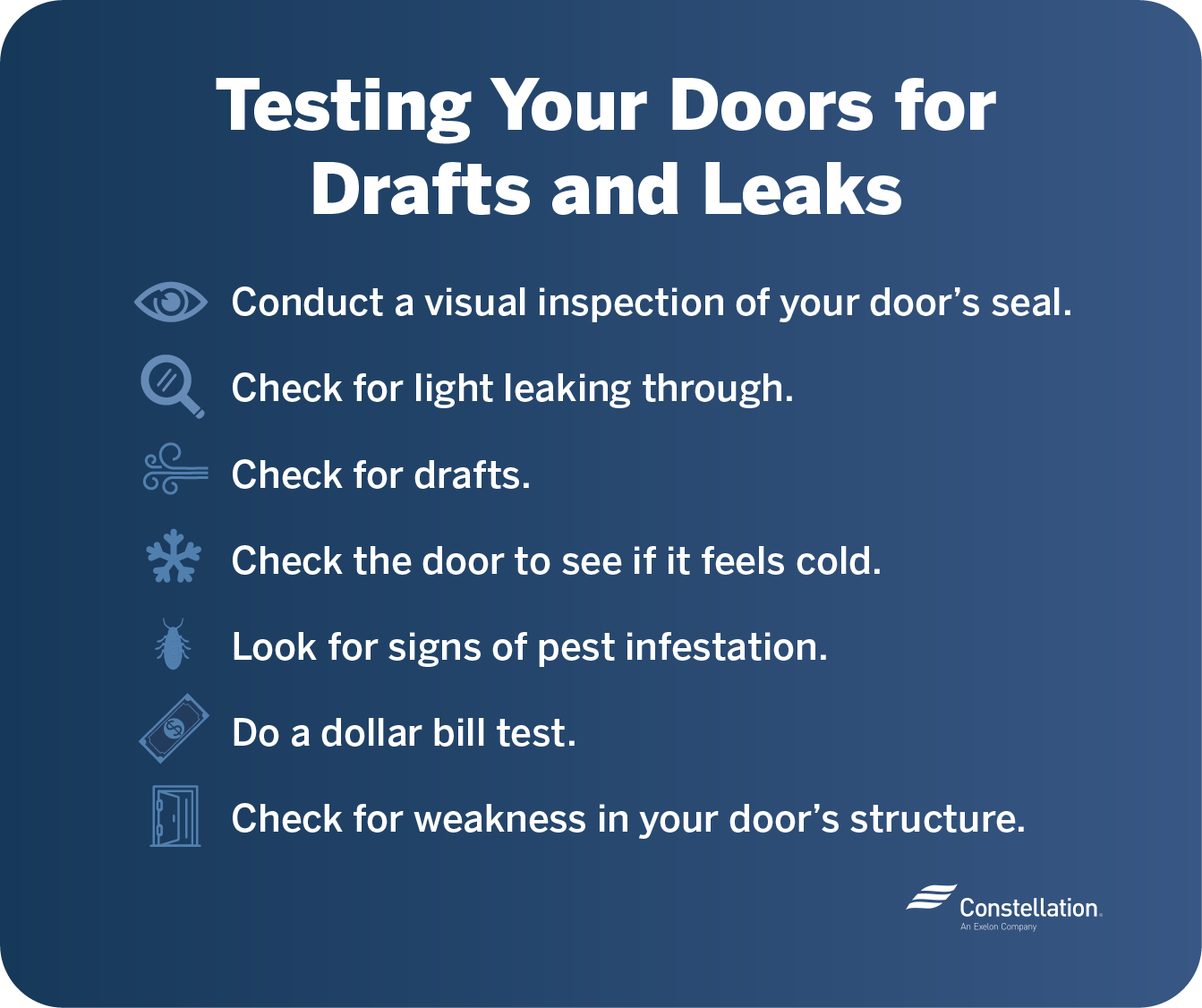
- Category:
Home Energy Savings - Published:
November 30, 2020
How Doors Affect Your Home’s Energy Use
If you want to find more ways to save energy at home, start with the front door. Energy efficient doors can have a major impact on your home energy use and while it may be tempting to purchase the most stylish or affordable door, we’ve put together a few tips to help you understand and increase the energy efficiency of your doors.
Are your doors energy-efficient?
Exterior doors come in a variety of materials–each with a different amount of insulation. Old-fashioned wood doors and glass doors have the least insulation. Steel and fiberglass doors are better insulators with layers of foam in their cores.
If you don’t know whether you need energy efficient doors, consider hiring a professional to audit your home’s energy use. They can give you a precise understanding of where you can get the most value by installing new energy saving doors and windows or improving your current doors.
How do energy-efficient doors benefit your home?
Door manufacturers have made tremendous advances in designing energy efficient doors that earn an ENERGY STAR® rating. You can find a variety of styles and materials in energy efficient front doors that could lower your energy bill. Here are the primary benefits of energy efficient doors:
- Lower your energy costs. A properly installed and well-insulated door will not leak or radiate heat in the winter. In the summer, it does a better job of keeping cool air inside. In both cases, you’ll consume less energy keeping your home at a comfortable temperature.
- Help you earn tax incentives. You can earn an energy efficient home improvement tax credit when you replace old doors with qualified ENERGY STAR® new ones.
- Protect your home from the elements. Energy efficient doors do more than keep drafts down. They also keep out moisture that can lead to the growth of mold and keep insects and pests out of your home.
- Reduces your carbon footprint. An energy efficient door lowers your carbon footprint as you use less energy maintaining a warm–or cool–home.
Selecting the most energy-efficient doors
Buying energy efficient doors does not have to involve mystery. New doors that have been through testing are labeled with their ENERGY STAR rating, their U-factor, R-factor and their Solar Heat Gain Coefficient measurement.
Learn more about ENERGY STAR ratings and the efficiency of doors at Energy.gov. You can also look for the National Fenestration Council Rating label that makes comparisons of energy ratings easy to understand. And, if you want to know about those -values, keep reading.
What is the U-value of a door?
The U-value of a door is the rate at which heat transfers through the door. A well-insulated door has a lower U-value. A standard, one inch thick wood door has a U-value of .65 whereas a well-made fiberglass door has a U-value of .09, making it one of the most energy efficient doors you can buy.
What is the R-value of a door?
The R-value measures a material’s resistance to heat flow. In the case of doors, higher is better. Energy efficient exterior doors with a high R-value will resist radiating heat, and thus provide better insulation.
Exterior Doors
The place where energy efficient doors matter most is on the exterior of your home. Good insulation and properly installed door weatherstripping makes a difference.

- Fiberglass doors. Fiberglass doors are among the most energy efficient and durable options. The flexibility of fiberglass means they can be made in a variety of styles and finishes. The foam core provides exceptional insulation. Fiberglass does not warp, rot or expand, which makes these doors nearly maintenance free. High end options are finished with wood veneers that give you the look of wood with the benefits of fiberglass.
- Wooden doors. Wood doors are a classic, however, they are the least energy efficient and come with high maintenance costs. They can absorb moisture and warp. Wood offers little in the way of insulation. If you opt for a wood door, also invest in a good storm door and weatherstripping
- Vinyl doors. Vinyl doors are a low-cost alternative to wood, fiberglass or steel doors. They are lighter in weight, yet provide good insulation. Sun can break down the plasticizers, so use care where you install them.
- Steel doors. Like other highly energy efficient front doors, steel doors use sandwich technology, wrapping an insulating foam layer within the steel. Because they are strong and do not warp, steel doors have no gaps where heat can be lost. Among the most energy efficient choices, steel doors offer extra security and sound proofing.
- Accessory: Doggy doors. Pet doors are a great convenience, however, they can be energy sinks. Look for insulated frames and doors. Make sure the flap seals tightly, even in windy situations, to keep heat in.
Interior Doors
Most interior doors have no insulation at all. For some rooms that is fine, but you may wish to install an exterior insulated door in some interior locations, such as a door to an attic, that could be subject to drafts.
- Solid-wood doors. Solid wood doors are beautiful and durable when used in home interiors. They are heavier than alternatives, however, and can warp under certain conditions.
- MDF doors. Medium density fiber doors are lightweight and inexpensive, making them an extremely common interior door choice.
- Hollow-core doors. These light and inexpensive doors have no insulation or sound proofing. Use care around them as they are not very durable.
How to test your doors
Before going to the expense of replacing an existing door with one of today’s more energy efficient front doors, you should see how well your current door is performing and if you have any air leaks in your home around it.

- Conduct a visual inspection of your door’s seal. Take a look at the insulation around your door. If it is missing chunks or is hanging loose in spots, you should replace it.
- Check for light. On a bright day, close your door and examine the edges from the inside looking out. If you see light, you don’t have a good seal. Heat is leaking out wherever there is light.
- Check for drafts. Light a candle by your door on a cold and blustery day. If the candle flickers when it is near the door, especially along the floor, your weatherstripping is not doing its job.
- Feel the door. Again, on a cold day, put your hand against the door. If it is very cold, you have little insulation and are leaking heat.
- Look for signs of pest infestation. A door that isn’t closing well will let insects, mice and other pests into your home. If you see signs of pests, your door isn’t sealed well.
- Do a dollar bill test. Use a dollar bill and see if you can slide it under and around your front door. If you can, you are literally throwing money out your front door.
- Check for weakness in your door’s structure. Older doors may not hang properly or the material from which they are made could be degrading, creating gaps that leak heat.
A new door can enhance the beauty and security of your home. If you make a careful choice and select an energy efficient front door, you can save enough money on your energy bill to pay for the door and its insulation.




